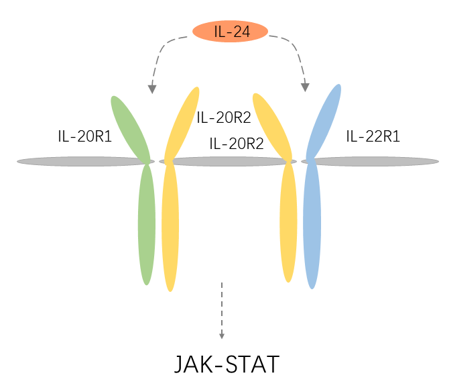Introduction
IL-24 is a member of the IL-10 family. It is expressed in human tissues with high tissue specificity. It is mainly expressed in monocytes, macrophages, T cells in immune tissues and organs such as spleen, thymus, peripheral blood, T lymphocytes, B lymphocytes and NK cells, etc. IL-24 can inhibit the proliferation of many cancer cells by inducing apoptosis without damaging normal cells. It can also resist angiogenesis, immune regulation, and increase the sensitivity of radiotherapy and chemotherapy.
Mechanism and Function
The receptor of IL-24 is composed of two heterodimers, which are IL-20R1/IL-20R2, IL-22R1/IL-20R2, which belong to type II cytokine receptors. IL-20R is mainly expressed in normal skin keratinocytes and testis, and IL-20R1 is the main communicator of IL-20R activity. IL-22R1 is mainly expressed in normal liver and kidney tissues and various tumor cells. IL-24 can bind IL-20R2 alone, but its co-expression with IL-20R1 or IL-22R1 not only increases the affinity, but is also necessary for receptor activation. After IL-24 is combined with IL-20 and IL-22 receptor complex, it can activate JAK/ signal transducers and activators of transcription (STAT) signal pathway, and rapidly increase the phosphorylation transduction of tyrosine in JAK/STAT complex Signal, thereby regulating cell proliferation, migration and apoptosis.
IL-24 has a great relationship with tumors. It can promote tumor cell apoptosis, inhibit tumor cell growth, inhibit tumor angiogenesis, inhibit tumor cell metastasis, etc., so that it has a wide range of selective anti-tumor effects and immune regulation. effect. And it can promote tumor cell apoptosis by increasing the synthesis of reactive oxygen species (ROS) and mitochondrial dysfunction. It can also down-regulate the synthesis of phosphatidylinositol 3-kinase/protein kinase B, focal adhesion kinase, matrix metalloproteinase 2/9, and inhibit cancer cell invasion and metastasis. IL-24 has a certain connection with prostate cancer. It can kill sensitive prostate cancer cells through the extra cellular signal-regulated kinase1/2 (ERK1/2) signaling pathway. In addition, it also has the effect of inhibiting tumor DNA repair. In breast cancer, IL-24 inhibits the growth of breast cancer cells through an anti-tumor-bystander effect. In liver cancer, IL-24 blocks the S and G2/M phases of the cell cycle. In cervical cancer, colon cancer, nasopharyngeal cancer and osteosarcoma and other tumor cells, IL-24 has played a significant role in growth inhibition and apoptosis. IL-24 can also induce the secretion of cytokines such as IL-6, TNF-α, IFN-γ, and stimulate T cell proliferation, thereby promoting the activation of the immune system. IL-24 has anti-angiogenic activity and reduces tumor micro vessel density by inhibiting angiogenesis. IL-24 can also induce apoptosis through the endoplasmic reticulum stress pathway. In tumor cells, IL-24 can induce the transcription of GADD gene, which is related to protein misfolding and DNA damage, such as lung cancer. IL-24 can also cause autophagy. The interaction of IL-24 and Beclin-1 and the clearance of autophagy-related gene 5 play a huge role in the transition from autophagy to apoptosis caused by IL-24. IL-24 is also related to pathological scars. Compared with normal skin, the expression level of IL-24 in pathological scars is lower.
 Fig 1. Mechanism of Signaling
Fig 1. Mechanism of Signaling
Creative Proteomics can provide cytokine detection platform for scientific research. According to different purposes, our dedicated analysts will customize exclusive solutions for you. We aim to provide customers with high-quality and convenient services to help you accelerate the progress of your project.
Our cytokine detection service includes but is not limited to:
- Quantitative and qualitative detection of cytokines in different species
- Quantitative and qualitative detection of cytokine antibodies
- Quantitative and qualitative detection of single/mulltiple cytokines
Sample requirements
- Sample Types-Blood, serum, plasma, cerebrospinal fluid, cell culture supernatant, tissue homogenate, cell culture medium, urine, tumor, etc.
- Sample Volume-It is optimal for at least 200µl of each sample. This volume allows for triplicate testing of each sample.
Our advantages:
- Efficient design: Multiplex reaction detecting in various methods are available, which can be selected according to different samples and requirements.
- Sensitive detection: High-quality antibodies are used in the detection process to improve detection specificity and accuracy.
- Reliable results: The feedback results are professional and efficient.
Technology platform:
We mainly provide the Luminex cytokine detection platform. Luminex uses fluorescently encoded microspheres with specific antibodies to different target molecules. The different microspheres can be combined freely to a certain extent so that up to 100 analytes can be tested multiple times simultaneously in a single experiment.
The Luminex cytokine assay platform has the following advantages:
- Multiple detection: simultaneous detection of 100 biological targets
- Short experiment time: 1-3 weeks
- High sensitivity: the lower limit of accurate quantification is as low as 0.1 pg/mL
- Save samples: only need a sample volume as low as 25 μL
- Time saving: the experiment process only takes 4 hours
For your different needs, we can also provide the following detection methods:
- Enzyme-linked immunosorbent assay (ELISA)
- Flow cytometry
Workflow

For more information about the IL-24 detection service or need other detection requirements, please contact us.
References:
- He M, Liang P. IL-24 Transgenic Mice: In Vivo Evidence of Overlapping Functions for IL-20, IL-22, and IL-24 in the Epidermis. Journal of Immunology, 2010, 184(4):1793-1798.
- Sarkar D, Su Z Z, Lebedeva I V, et al. mda-7 (IL-24) mediates selective apoptosis in human melanoma cells by inducing the coordinated overexpression of the GADD family of genes by means of p38 MAPK. Proceedings of the National Academy of ences of the United States of America, 2002, 99(15):10054-10059.



